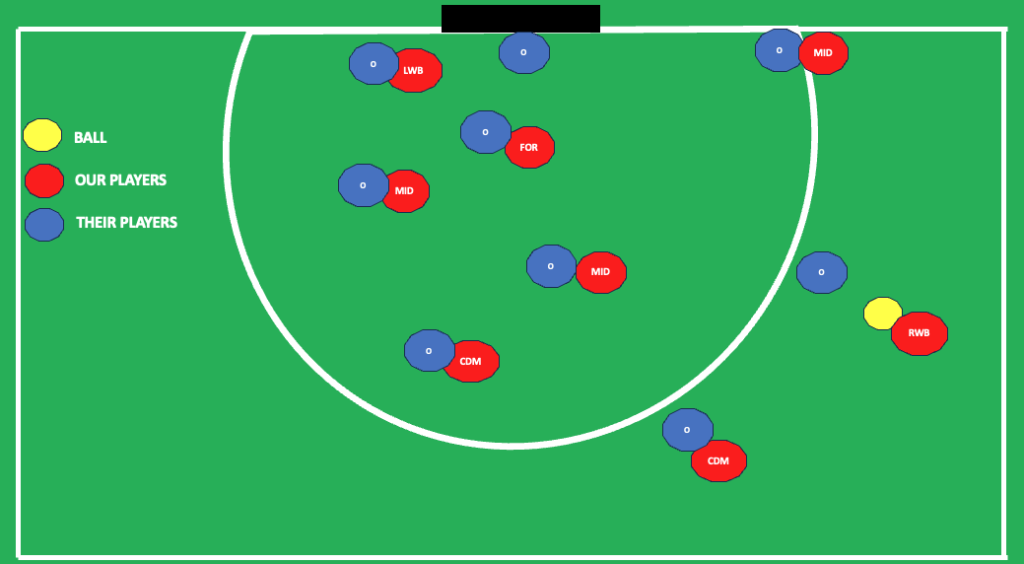HOW WE PLAY AS A TEAM
The structure, strategy and style we use to play together, will define whether we are successful with our mission.
In our county squad we will have players from various other enviroments, used to playing different ways, and we need to have a single identity which everyone has to be part of.
This page outlines some of the key principles for our squad and below are buttons which link to each playing position and the principles for these.
GENERAL PRINCIPLES
We have a few key principles for how we play as a squad. Everyone is expected to adhere to these:
EVERYONE IS A DEFENDER
It is everyones responsibility to prevent the other teams go forward, and to win back the ball.
We cannot win the game without possession of the ball.
We can only lose the game if we concede more goals than we score.
County hockey is supposed to be high-performance than club & school hockey, all high-performance players see themselves as much a “defender” as an “attacker” – This must be the case for our squad, we don’t have room for players who only play one or the other role.
EVERYONE IS AN ATTACKER
It is everyones responsibility to find the best route forward and score.
We cannot win the game without scoring goals.
We can only lose the game if we give away possession and give the other team an opportunity to score.
County hockey is supposed to be high-performance than club & school hockey, all high-performance players see themselves as much a “defender” as an “attacker” – This must be the case for our squad, we don’t have room for players who only play one or the other role.
WORK HARD, PLAY HARD
Hockey is a seriously intense physical game. The ball moves so fast that you need to work incredibly hard all of the time. This is why “performance” sides have 5/6 subs who constantly rotate……. while you are on the pitch, you need to work your socks off.
One of your biggest assets is you are a fun bunch, we need to bring that energy to our games. You may not notice, but your enthusiams keeps you and the whole team going, even when times are tough…… keep having fun with it, take the mickey out of Terry, laugh at eachothers jokes, share sweets and stories, make it fun for everyone.
OUT OF POSSESSION PRINCIPLES
We must all recognise that when the other team have the ball, our job is to quick find “THE BEST OPTION TO STOP THEIR GO FORWARD AND WIN THE BALL BACK”.
As well as the out of possession strategies we play as a team, the below principles are the key points of how we play as a team, when we do not have the ball.
EVERYONE* BACK INSIDE THE LAST QUARTER
If the opposition have the ball (or look like they are going to get the ball) in our last defensive quarter, EVERYONE* should be back inside this area.
Inside this quarter, we should be “player to player” marking AND have at least one person pressuring the ball carrier……THERE IS NO NEED TO MARK ANYONE OUTSIDE OF THE LAST QUARTER – If you don’t have someone to mark, go and pressure the ball.
Pressure on the ball should be to prevent the ball going foward into the D or at goal.
It doesn’t matter who does which job BUT the closest person to the ball must put pressure on, then everyone else find a player to mark. Work through this process:
- CLOSEST TO THE BALL – Slow down play, stop a pass or the player carrying. Don’t just fly in with a tackle and risk the ball going past. You should have support coming, just slow things down for now.
- FIND A PLAYER – Once you are sure you are not the player closest to the ball (or someone was closer), find a player to mark.
- GO HELP THE BALL PRESSURE – If you look around and everyone is marked, go an help put pressure on the ball. Once you are there, workout if you should be slowing play down or tackling.
* The only exception is our Forward…… They must be tracking the ball so when we get the turnover, they can be passed to…… OUT FOWARD SHOULD ALSO PRESS THE BALL IF IT IS PASSED BACK OUT OF THE LAST QUARTER
(In the diagram, you can see a situation where the opposition have 7 players in our last quarter. Each of these players are marked and 3 of our players are putting pressure on the ball)
REMEMBER LONG CORNERS – Watch if a long corner is conceded, exactly the same principle applies.
THERE IS NO NEED TO MARK ANYONE OUTSIDE OF THE LAST QUARTER – Just repeating this as its important, we must have more players than them inside the area, it doesn’t matter if they play around with the ball outside, we are denying their go-forward.
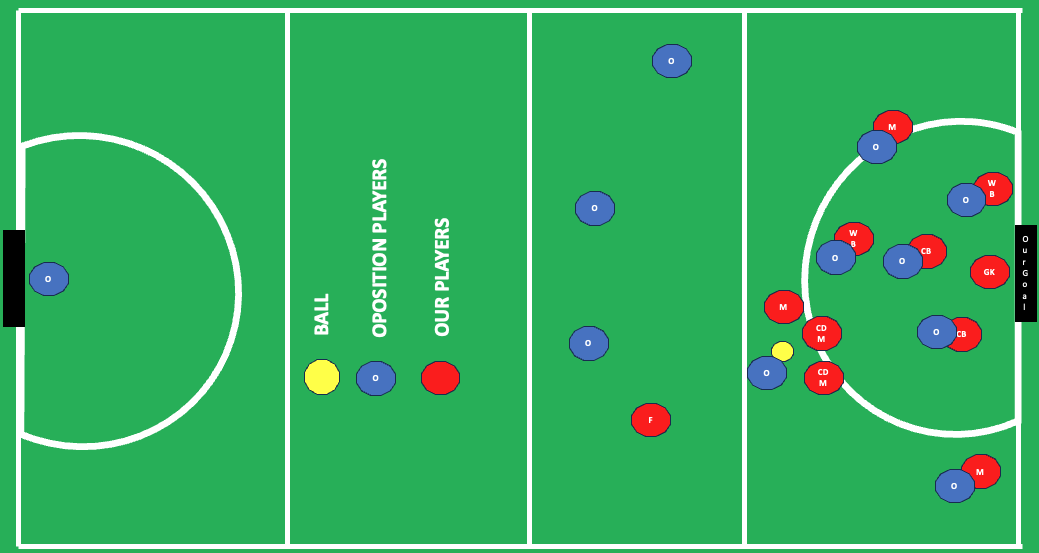
WIN THE BALL IN PAIRS
One of our biggest challenges is that we try to make tackles, the ball goes past us and we cause problems for the players behind (often the goal-keeper when it is one of our defenders).
We need to get in the mindset that IF we are the first player to the ball, we are not going to tackle*, we are just going to “PREVENT THEIR GO FORWARD”.
However, we do want the ball back, so we will try to win the ball in pairs.
This requires a lot of thinking from all players on the pitch. For this to work, everyone need to recognise the situation and be part of the solution.
The following 3 images show a situation where an opposition midfielder has just been passed the ball. These are the 3 stages we need to work through as the out of possession team:
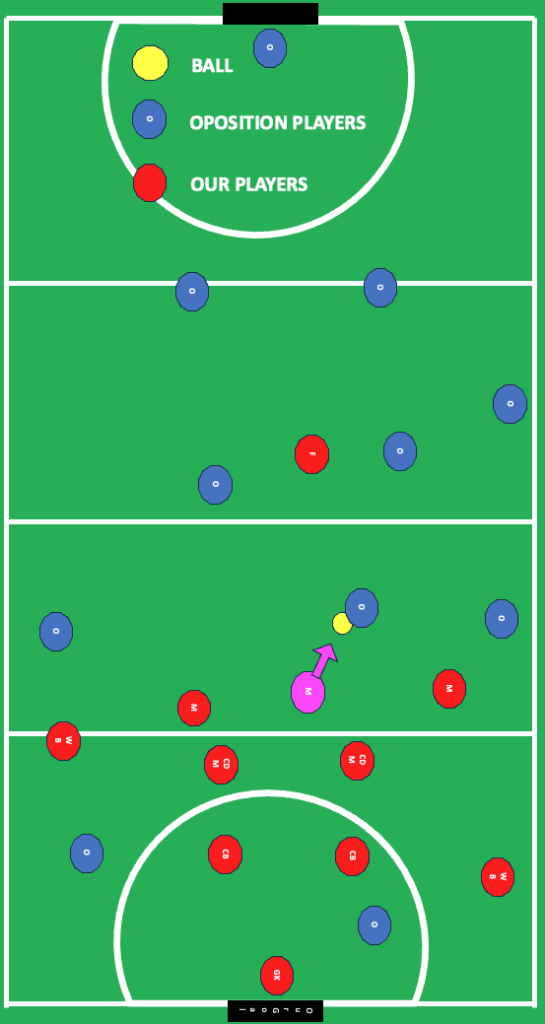
In this first image you can see that one of the blue team (opposition) has received the ball in the middle of the pitch.
They will be trying to go forward.
Our player highlighted in pink is the closest to the ball, so they must position themselves to try and slow down/prevent the playing going forward.
THEY DO NOT TACKLE
A good outcome at this stage would be to stop any forward pass or slow down or prevent the person with the ball carrying forward.
Any backwards pass or carry from here is fine, this is not a situation to WIN the ball, just stop them going foward.
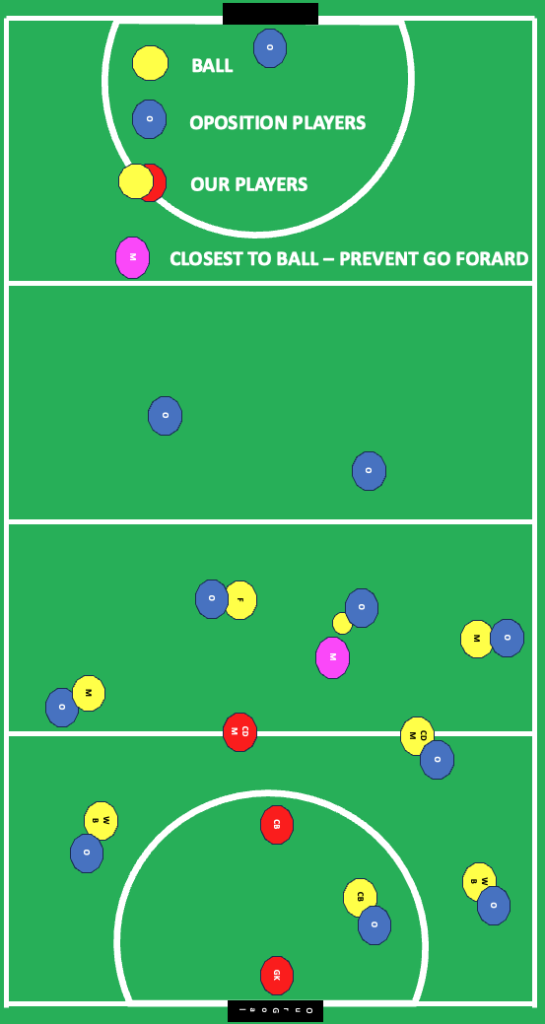
In this second image you can see that the other team has all started to go forward into attack.
Look at our players (now highlighted in YELLOW), they have all found their closest player and are front marking to prevent them being passed too.
However, WE DO NOT NEED TO MARK ANYONE BEHIND THE BALL, we are happy for the other team to pass backwards…….. what this means is we now have two spare players (spare in that they do not have anyone to mark).
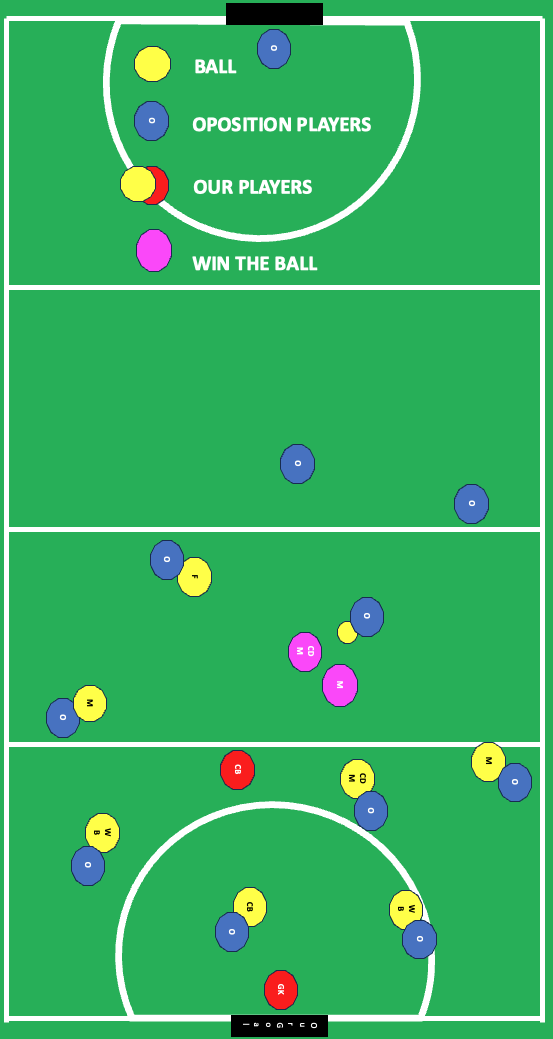
In this third image you can see that the other team has to keep moving about to find space……. but our yellow players are continuing to mark them…… STAY WITH YOUR PLAYER, WHEREVER THEY GO.
Now though, one of our spare players has gone to join the player putting pressure on the ball….. When the time is right, one of these players can try and tackle.
If we win the ball in this situation, we are more likely to be able to go forward as you have an immediate 2v1
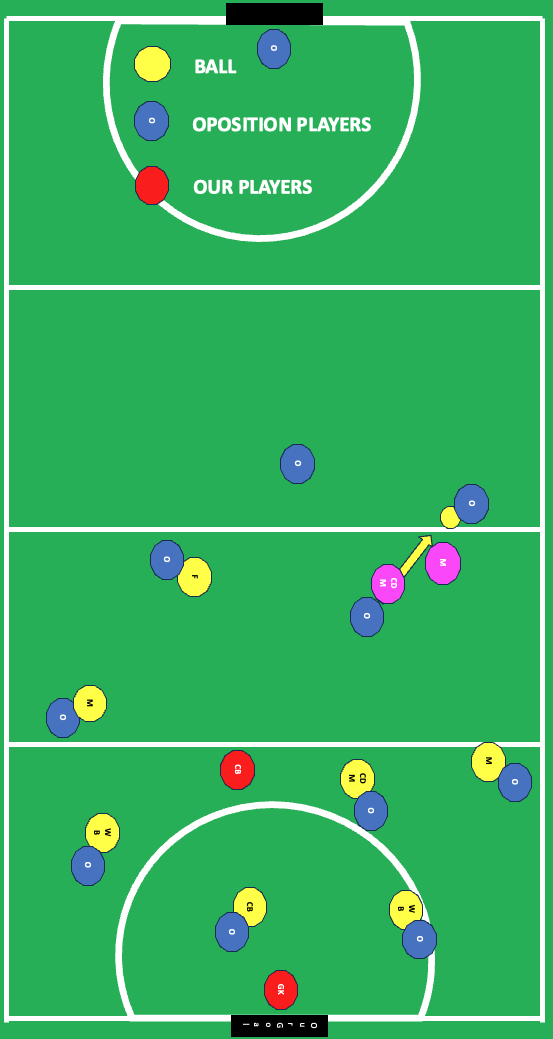
In this fourth image you can see that the player on the ball has decided they need to pass backwards and rebuild (an ok outcome for them).
This would also be a continued opportunity for us.
See how one of our players now moves in to a marking position (marking the player who previously had the ball).
The other player continues to pressure the ball and prevent any further go-foward.
We still have a spare player. So we could now move the whole process foward and eventually try to with the ball from the player in possession again.
WE USE A PRESS TO TRY AND WIN THE BALL
Our squad is such a clever bunch, we can use a press to force errors and win the ball.
This strategy is what makes us a high-performance team.
We understand three difference presses and use them depending on the game situation.
As a reminder, these are the three press option we have:
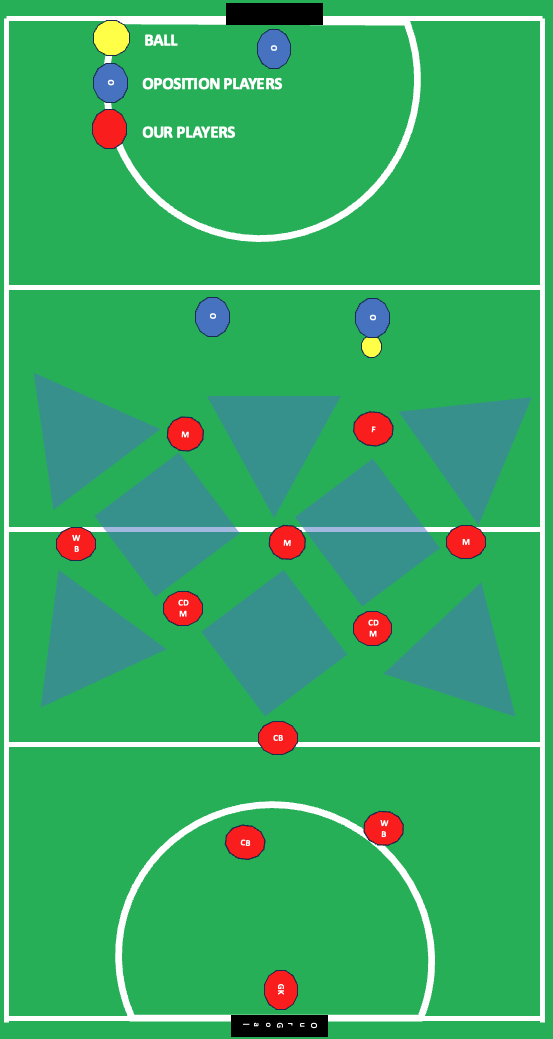
ZONAL PRESS
Our go to press is the zonal press.
This press creates “zones” into which we are happy for the opposition to play the ball, because we believe we can put pressure here and win the ball.
The general principles of this press are:
- Make it difficult for the opposition team to play from free hits OR in open play from their back line.
- Hold back from making tackles as individuals, but entice the oppositon in to a zone where we can win the ball as a team.
To make this press work, everyone needs to:
- Understand the zones that we are looking to create and FORM THE PRESS as soon as possible
- Be disciplined and hold the shape NOT get drawn out of position
- Make sure we collapse the zones as soon as the ball is played in to them.
- COMMUNICATE – Its so important to tell the players in front of you what to do, whether they are in the right position, not to chase the ball, etc etc.
If the opposition get through the press, it is important to track back quickly. The benefit is because there are 3 lines in one press, its not so far to get back for most.
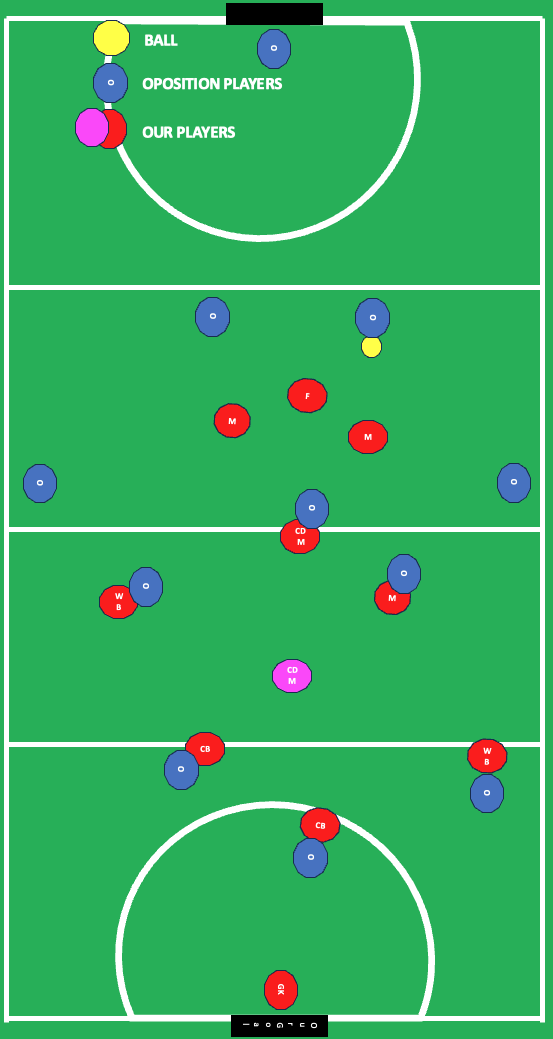
FULL PRESS
We also use a version of full press, in which we play with a spare player.
The 3 furthest forward players are responsible for the oppositions 4 defenders. Their responsibilities are:
- Try to prevent the opposition passing in to the middle of the pitch
- Try to trap the ball out at the sideline
- Win the ball back between the 3 of you when it is at the side of the pitch
Everyone else (except one of the CDM’s) should mark an opposition midfield or forward player. When marking:
- If you are close to the ball (within a quarter of the pitch), mark from behind
- If you are further than a quarter of the pitch away, mark from in front of the player (just keep track of where they are and block the path of the ball to them)
The spare player is the first to assist whichever “marking” player need their help.
This press is very hard work for the forward players. Given our principles around “Everyone back inside the last quarter” and “Win the ball in pairs”, we need to keep our forwards fit, so we will only play this press if the game dictates we need to.
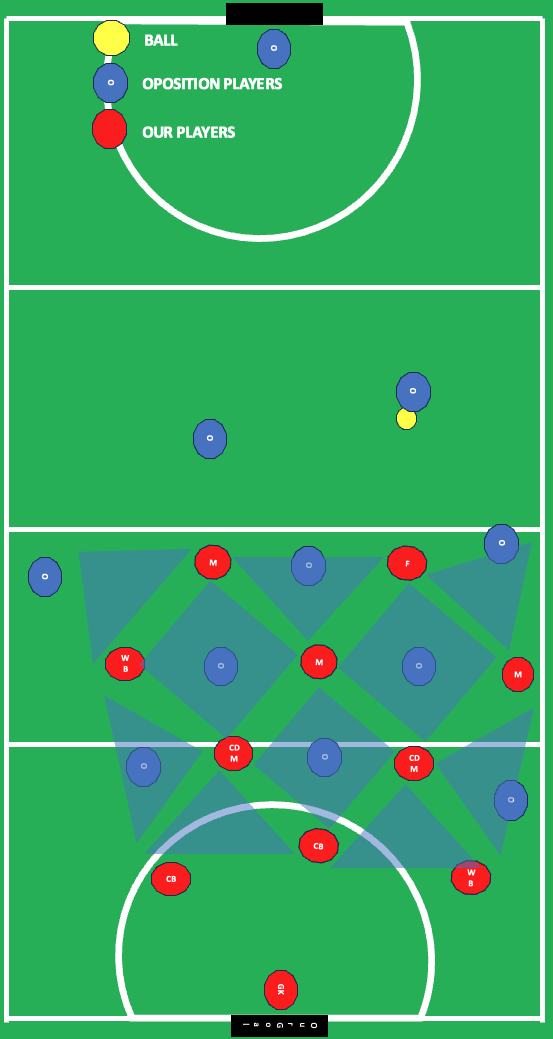
HALF-COURT PRESS
There are times in the county championship games where we will play a half-court press. This is an uncommon press, and it will feel very weird playing it.
With two games in a row, this press can be useful to reserve energy.
Also, against some of the better counties, we just need to make ourselves very difficult to beat, this is the press for that.
It’s weird though.
We play our zonal press BUT only in our defensive half of the pitch. This makes our half of the pitch very busy, and very hard to play through.
If they have a 16, we all get back in to our half of the pitch. If they have a free-hit anywhere in their half of the pitch, we all get back in to our half.
To make this work, you must hold back in our half of the pitch, or gaps start to appear and a route through is possible.
IN POSSESSION PRINCIPLES
When we have the ball, we follow some basic principles to help us with some key points:
- Everyone prefers to attack, lets keep the ball as long as possible
- We need to use our skills, which are strength and speed
- We need to score goals to win
Therefore, our in possession principles are outlined below:
KEEP THE BALL
We have had some problems in the past in that we do well to win the ball, or get given opportunities from free-hits, but we give the ball away to easily and often from positions where we are then under immediate pressure.
We need to keep the ball when we have possession. This is totally down to you, some tips include:
Pass early – normally early passes mean the opposition don’t have a chance to read them, and then intercept. If you can pass early, you are more likely to complete the pass.
Forward is not always the best route to go forward – The only safe space left on the pitch might be behind you. Don’t always go forwards, and always try not go forward in to a busy or risky area.
It’s not just the ball carrier who is responsible for keeping the ball – When we don’t have the ball at our stick but our team is in possession, we have to create space. Either to be passed to safely, or for others to make progress by clearing defenders out of their path.
GO FAST
The quicker we go forward, the more likely we are to be successful.
While there are lots of decisions to make, try to complete your next action as quickly as possible.
Flood the circle
Our structure allows us to have 8 players going deep forward.
When we have the ball inside the opposition last quarter, we should have 8 players in that area and at least 4 should be inside the circle.
Generally we need a player on the pen spot and one at the back post. But everyone should be changing position and creating space, all of the time.
Our goal should be for every player on the team (perhaps with the exception of the two centre backs) to score at least one goal over the championships. To do this, we must get in the circle.
